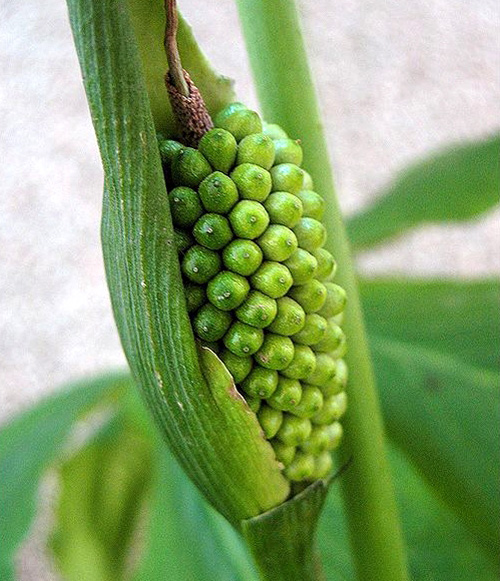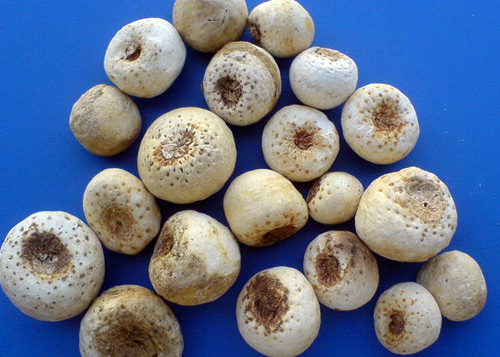The source is from rhizome of Pinellia ternate (Thunb.) Breit, family Araceae. The medicinal material is produced in all parts of China and mostly in the reaches of the Yangtze River, dug and collected in summer and autumn, prepared by being dried in the sun after the cortex is removed and the fibrous root is got rid of. The crude or the one prepared by being soaked in ginger juice and alum water is used.
Medicinal Properties: Pungent in flavor, warm in nature, toxic and attributive to the spleen, stomach and lung meridians.
Actions: Dry dampness and eliminate phlegm, lower the adverse rising qi to stop vomiting, disperse stagnation and lumps and externally disperse swelling and relieve pains.

Application
1. It is used for dampness or cold phlegm syndrome and is an essential medicinal herb to treat dampness-phlegm syndrome. For cough and asthma with plenty of sputum caused by accumulation of phlegm and dampness in the lung, it is usually combined with Jupi (Pericarpium Citri Tangerinae ) and Fuling (Poria), such as Erchen Tang (Decoction); for that accompanied by cold, profuse and thin sputum, Xixin ( Herba Asari ) and Ganjiang (Rhizoma Zingiberis) may be added to the above combination; for that with fever, thick and yellowish sputum, it must be combined with Huangqin (Radix Scutellariae ), Zhimu (Rhizoma Anemarrhenae) and Gualou ( Fructus Trichosanthis); for dizzines caused by damp turbidity upattacking, it is usually combined with Baizhu (Rhizoma Atractylodis Macrocephalae ) , Tianma (Rhizoma Gastrodiae), etc., such as Banxia Baizhu Tianma Tang (Decoction).
2. For vomiting due to the adverse-rising of stomach-qi, it is usually combined with Shengjiang (Rhizoma Zingiberis Recens); for that due to stomach-deficiency, combined with Renshen (Radix Ginseng ) and Baimi (White Honey), named Da Banxia Tang (Decoction); for that due to stomach-heat, combined with Huanglian (Rhizoma Coptidis ), Zhuru (Caulis Bambusae in Taeniam), etc.; for that during pregnancy, used together with Zisugen ( Caulis Perillae ), Sharen ( Fructus Amomi ) and others that regulate qi and prevent fetus from miscarriaging and regulate the function of the stomach to stop vomiting.
3. It is used for stagnation and oppression in the chest and epigastric abdomen, and globus hystericus.For the former syndrome and vomiting due to co-stagnation of phlegm and heat, it is usually combined with Huanglian (Rhizoma Coptidis ) and Gualou (Fructus Trichosanthis), named Xiao Xianxiong Tang (Decoction); for the latter due to stagnation of qi and phlegm or stagnation of something or so in the throat, used together with Houpo ( Cortex Magnoliae Officinalis), Zisuye ( Folium Perillae) and Fuling (Poria), etc., such as Banxia Houpo Tang (Decoction).
4. It is used for goiter, subcutaneous nobule, large carbuncle and mammary sores. For goiter and subcutaneous nobule, it is used together with Kunbu (Thallus laminariae seu Eckloniae), Haizao ( Sargassum ), Zhebeimu (Bulbus Fritillariae Thunbergii)and others that soften hardness and disperse lumps; for large carbuncle, its crude powder mixed with egg white is applied on the wounded area, which can also be used to treat poisonous snake bite.

Usage and Dosage:
3 - 10 g is used in decoction for oral use. Just right amount of the raw is used externally and ground into powder that is mixed for application.
Notes:
Since it is warm and dry in nature, it is contraindicated or used with caution for dry cough due to yin deficiency, hemorrhagic diseases and heat-phlegm. It is incompatible with Wutou (Rhizoma Aconiti).
Explanation:
The prepared Banxia is usually taken orally, that is, Jiangbanxia, Rhizoma Pinelliae prepared with ginger and alum, Fabanxia, that prepared with Gancao (Radix Glycyrrhizae ) and lime, and Zhulibanxia, that prepared with Zhuli (Succus Bambusae) and alum. Jiangbanxia is effective in lowering the adverse-rising qi to stop vomiting, so it is usually used for vomiting; Fabanxia is effective in eliminating dampness but its warm nature is weaker, so it is usually used for syndrome of dampness-phlegm; Zhulihanxia is cool in nature and can eliminate phlegm-heat, so it is mainly used for phlegm of heat and wind types.







